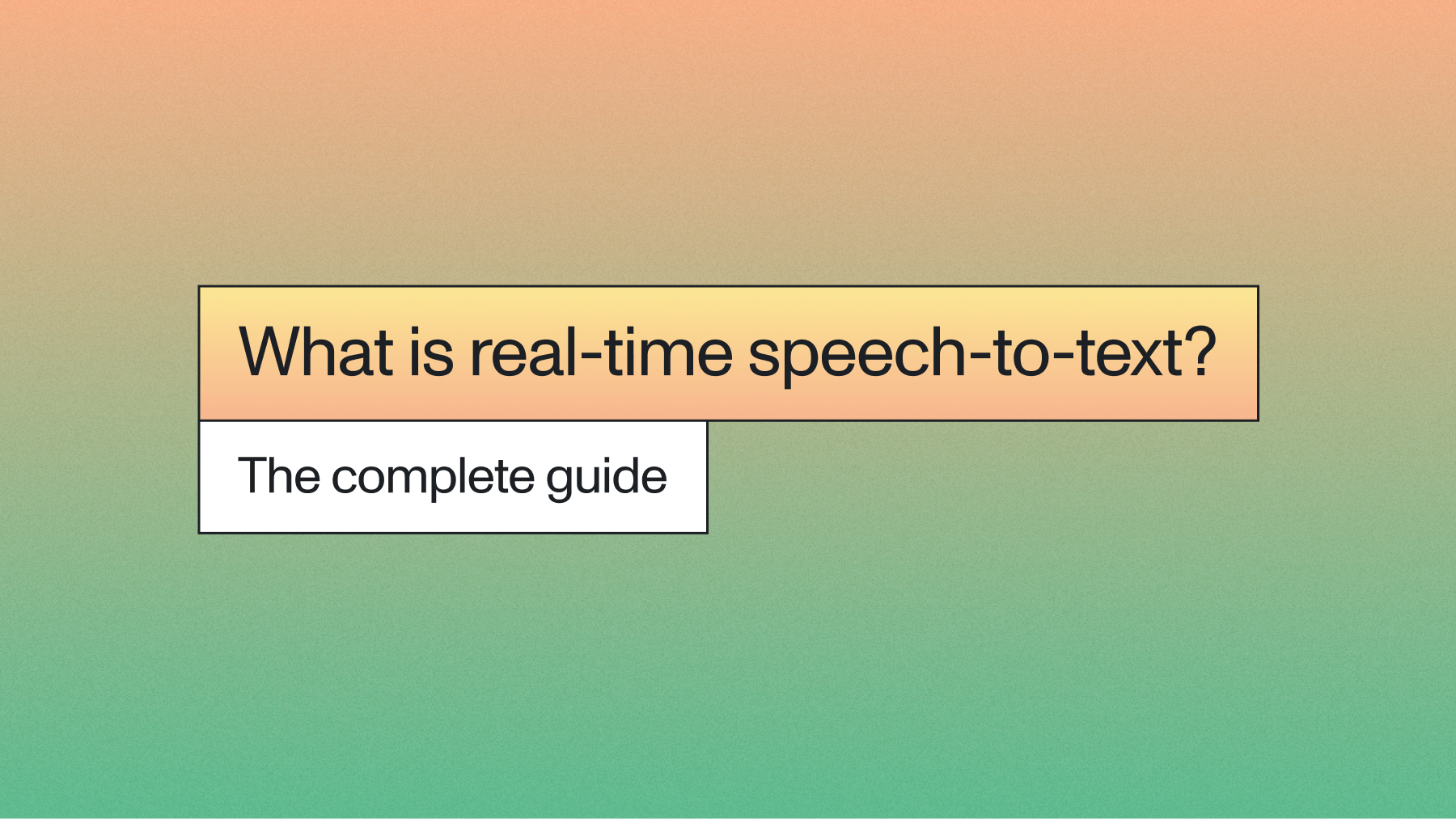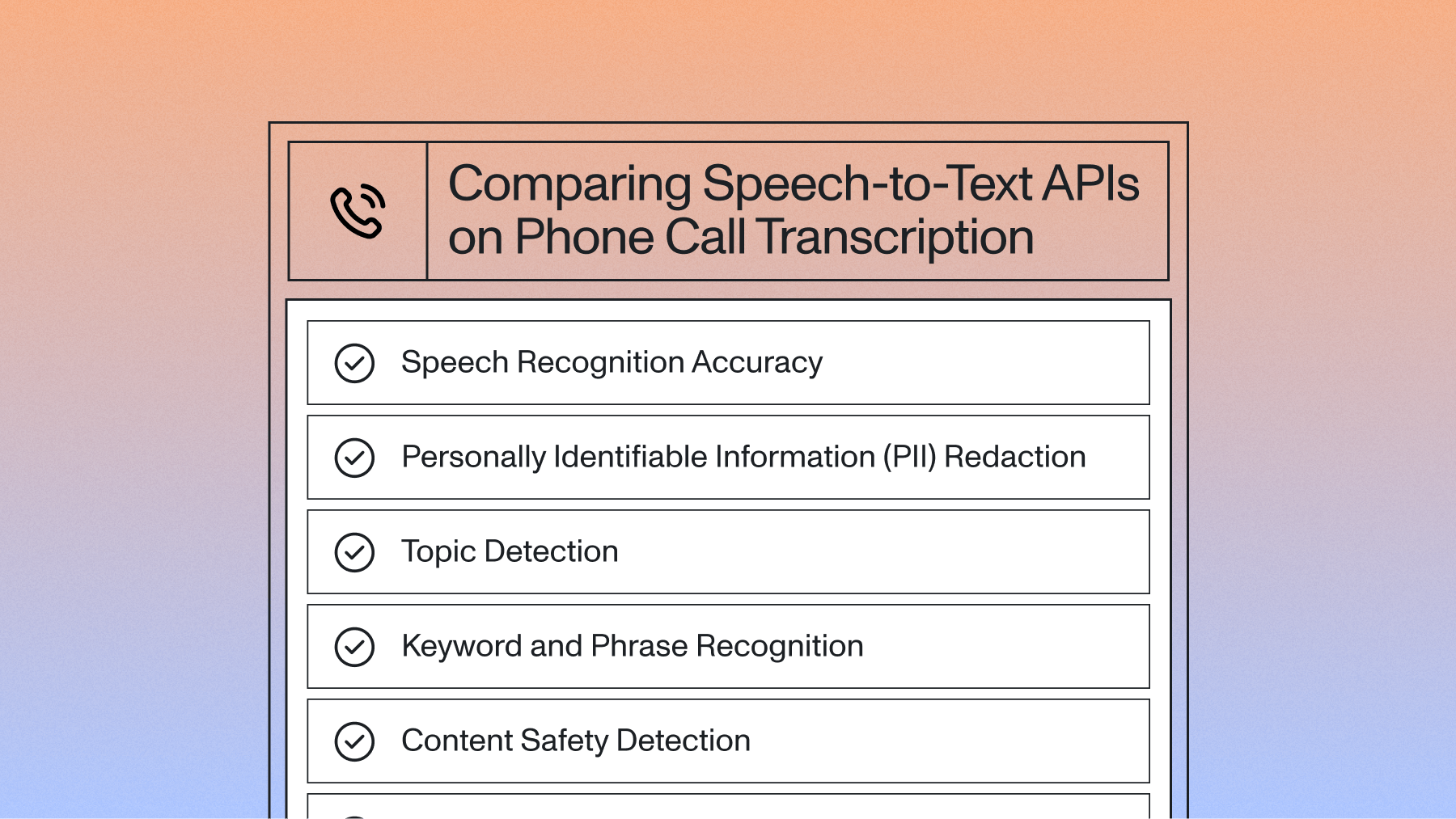Real-time conversation intelligence: The shift from post-call analysis to live insights
Real-time conversation intelligence is transforming customer interactions from post-call analysis to live insights. Learn how streaming speech-to-text enables proactive engagement.

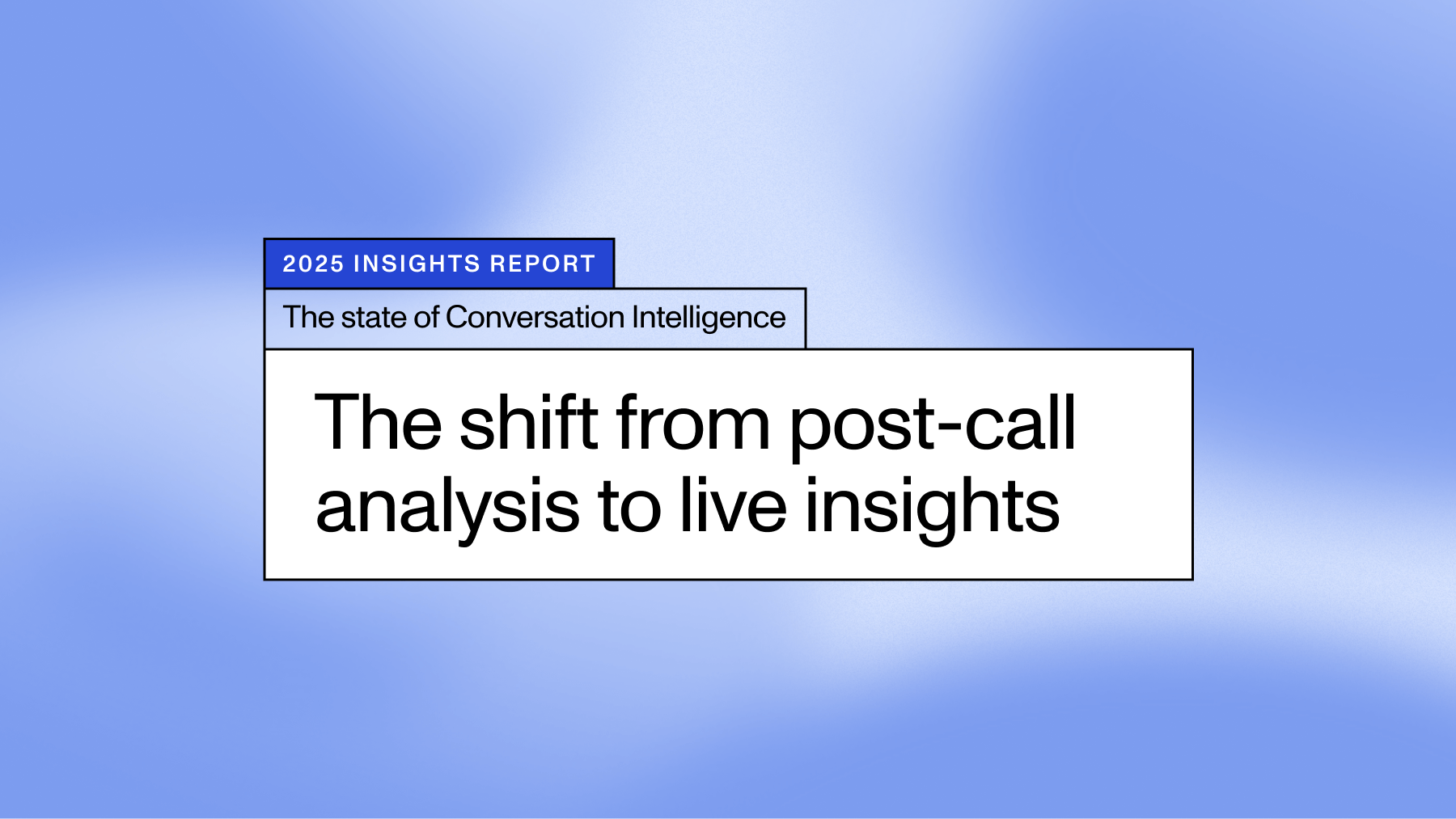

Conversation intelligence transforms raw customer interactions into strategic business insights by using AI to capture, transcribe, and analyze conversations across channels. This technology has evolved from basic post-call analytics to real-time systems that can influence outcomes while conversations are still happening.
The 2025 State of Conversation Intelligence Report reveals that more than 80% of respondents predict real-time conversation intelligence will be the most transformative market capability in 2025. As organizations move from reactive analysis to proactive intelligence, they're discovering how streaming speech-to-text and Voice AI enable them to act on insights during the moments that matter most.
This guide explores what conversation intelligence is, its business benefits, and how real-time capabilities are transforming customer interactions across industries. We'll examine the technical foundations that make this possible and dive deep into a practical use case showing how real-time agent assist delivers immediate value.
What is conversation intelligence?
Conversation intelligence uses AI to automatically capture, transcribe, and analyze customer conversations, transforming raw audio into actionable business insights. Unlike traditional call recording, this technology extracts key topics, sentiment, and performance patterns that drive measurable improvements in sales coaching, customer satisfaction, and operational efficiency.
Modern conversation intelligence platforms combine several Voice AI technologies to transform unstructured conversations into structured data. Core Speech-to-Text converts spoken words to text. From there, Speech Understanding models can identify topics and sentiment, while frameworks like LeMUR allow developers to apply Large Language Models (LLMs) to extract key information like action items, decisions, and customer intent.
This creates a comprehensive understanding of customer interactions that drives better business outcomes. Sales teams identify winning talk patterns, support organizations monitor quality across every interaction, and product teams mine conversations for feature requests and pain points.
The difference between conversation intelligence and traditional call recording is like the difference between having a transcript and having a strategic advisor. While recordings capture what was said, conversation intelligence reveals what it means, why it matters, and what to do about it.
Key business benefits of conversation intelligence
Organizations implementing conversation intelligence gain competitive advantages through enhanced visibility into customer interactions and automated workflows that previously required manual effort. The technology delivers value across multiple dimensions:
Improved sales performance and coaching
Conversation intelligence automatically identifies successful talk patterns, objection handling techniques, and closing strategies from top performers. This enables systematic coaching improvements across sales teams:
- Performance replication: Teams replicate winning behaviors systematically across the organization
- Coaching precision: Managers pinpoint specific improvement opportunities based on actual conversation data
- Measurable outcomes: Organizations report 15-20% improvements in win rates and 10-15% shorter sales cycles
Enhanced operational efficiency
Automated workflows eliminate hours of manual administrative work while improving quality assurance coverage:
- Administrative reduction: Call summarization and CRM updates happen automatically
- Quality scale: Monitor 100% of conversations instead of small samples
- Resource optimization: Handle 30-40% more volume without proportional headcount increases
Better customer experience
Understanding customer sentiment and satisfaction drivers at scale enables proactive service improvements. Organizations identify trending issues before they escalate and personalize interactions based on conversation history.
- Issue prevention: Detect emerging problems from conversation patterns
- Personalization: Tailor interactions based on customer history and preferences
- Consistency: Ensure uniform service quality across all touchpoints
Stronger compliance and risk management
Automated monitoring ensures every conversation meets regulatory requirements and internal quality standards. The system flags potential violations in real-time and maintains comprehensive audit trails.
- Real-time alerts: Immediate notification of compliance violations
- Complete coverage: 100% monitoring vs. traditional sampling methods
- Audit readiness: Automated documentation for regulatory reviews
Data-driven decision making
Conversation intelligence transforms anecdotal feedback into quantifiable insights. Product teams understand feature requests at scale, marketing teams track message resonance, and leadership teams make strategic decisions based on comprehensive customer voice data.
Conversation intelligence use cases across industries
While conversation intelligence originated in sales organizations, its applications now span every industry and function that relies on customer conversations. Leading companies are finding innovative ways to extract value from their conversational data:
Sales and revenue teams
Sales organizations analyze deal conversations to improve forecast accuracy, identify at-risk opportunities, and understand competitive positioning. Companies like Clari and Dialpad have built entire platforms around these capabilities, helping sales teams close more deals faster.
Key applications include:
- Deal risk identification through conversation pattern analysis
- Competitor mention tracking and objection handling
- Real-time coaching during live sales calls
Customer support and contact centers
Support organizations use conversation intelligence to monitor agent performance, ensure quality standards, and identify emerging issues. By analyzing conversation patterns, support teams reduce average handle time by 20-30% and improve first-call resolution rates.
Common implementations include:
- Automatic ticket classification and routing
- Sentiment-based escalation triggers
- Proactive issue resolution based on trending topics
Healthcare organizations
Healthcare providers use conversation intelligence for automated patient documentation and quality assurance. Nuvia Dental Implant Center leverages this technology to ensure consistent patient communication while reducing documentation time by 40%.
Key healthcare applications include:
- Automated clinical note generation
- Treatment plan adherence monitoring
- Regulatory compliance verification
Financial services
Banks, insurance companies, and financial advisors implement conversation intelligence for regulatory compliance and client relationship management. Every client interaction is automatically monitored for required disclosures, suspicious patterns, and service quality.
Critical use cases include:
- Automated compliance monitoring for MiFID II and other regulations
- Fraud detection through conversation pattern analysis
- Client satisfaction tracking and service improvement
Product and marketing teams
Product organizations mine customer conversations for feature requests, usability issues, and competitive intelligence. Marketing teams track how messaging resonates in real customer interactions, accelerating product-market fit and improving go-to-market strategies.
The evolution toward real-time conversation intelligence
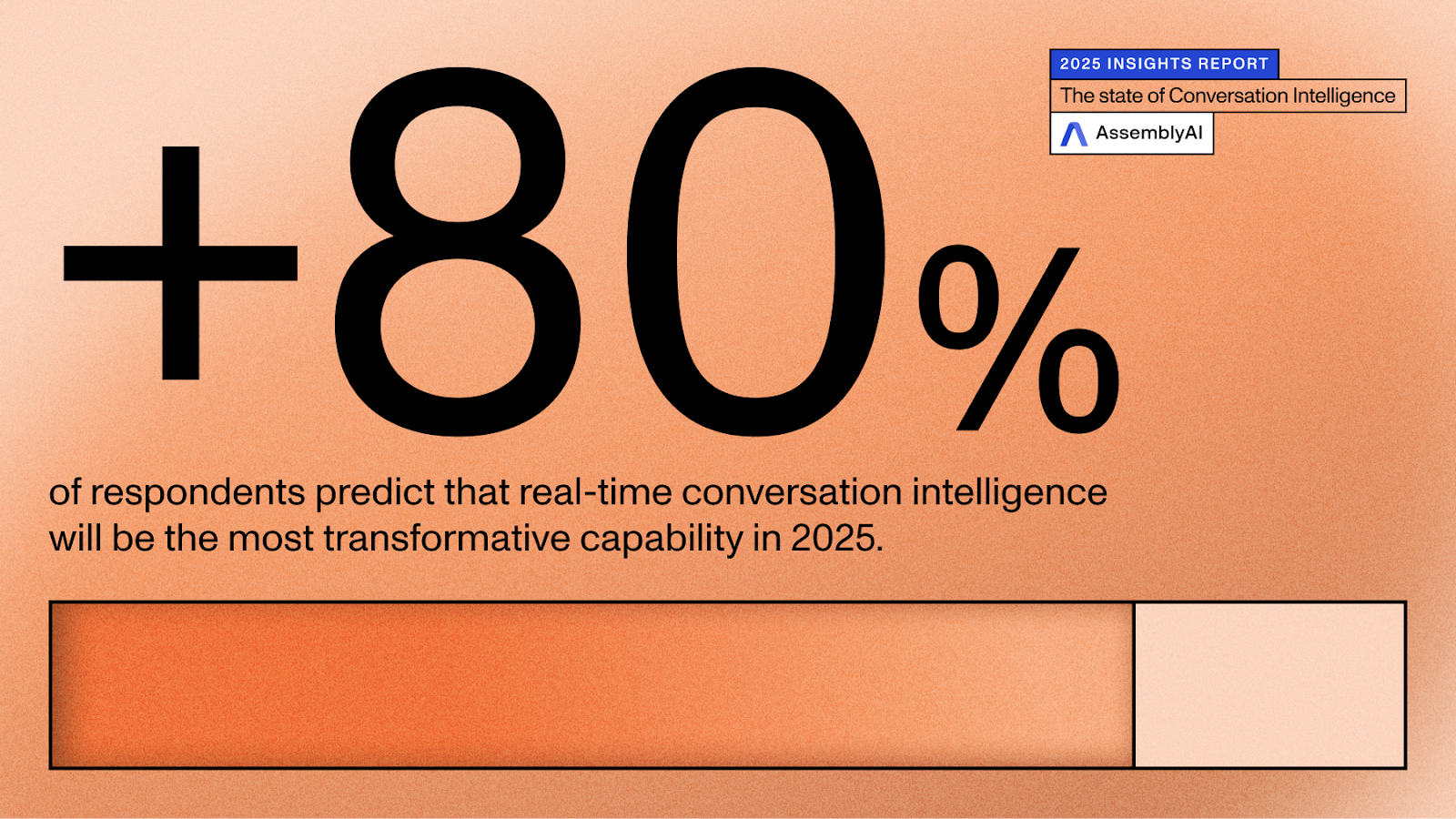
The 2025 State of Conversation Intelligence Report shows that 80% of teams integrated conversation intelligence more than a year ago, and real-time capabilities are emerging as the next requirement. As the technology moves from experimental to business-critical, organizations are shifting from post-call analysis to live insights that can influence outcomes while conversations are still happening.
"If there's one thing we heard loud and clear, it's that real-time capabilities are the next requirement. Whether live transcription, in-the-moment coaching, or agentic workflows, the shift is already underway," explains Jason Tatum, VP of Product at CallRail.
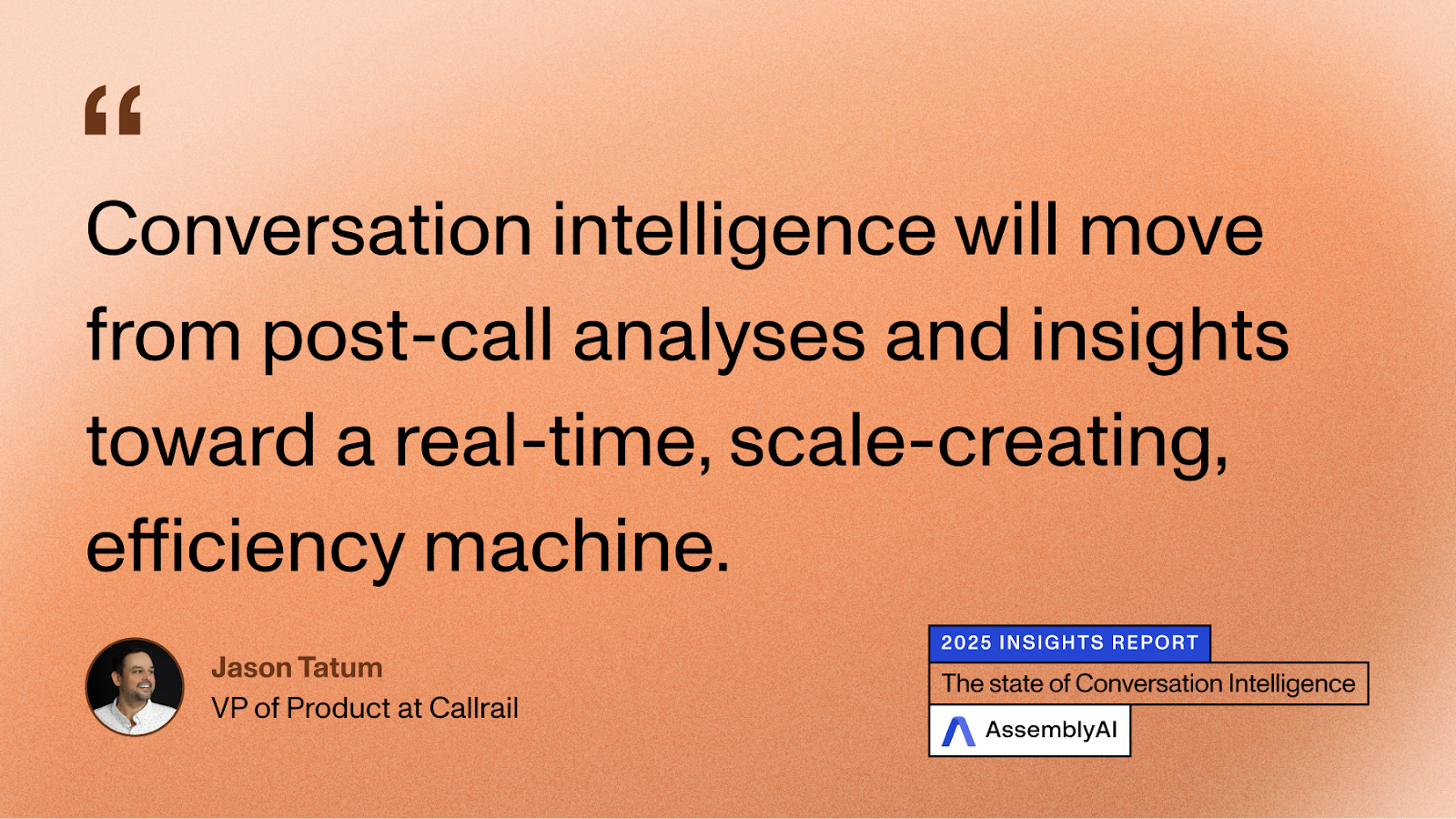
The data supports this direction. When asked about future capabilities, 61.5% of respondents identified voice agents with real-time conversation control as most exciting, while 47.37% listed adding real-time speech-to-text and agentic workflows as a top investment priority for the next year.
Three key factors are reshaping the industry:
- Cost reduction and efficiency gains push teams toward automation and real-time workflows. "[There will be a] huge focus on real-time functionalities—coaching and so on. Also on automation—getting answers in front of people before they even think of the question," notes Galya Dimitrova, Head of Product.
- Advancements in AI models enable better contextual understanding. "Strong, sustained tailwinds from improving model accuracy will bring conversational intelligence into more workflows," observes Craig Bonnoit, Founder/Co-founder.
- Demand for better customer experience drives personalization at scale with embedded AI agents. "Businesses will leverage hyper-personalization using AI-driven insights to tailor customer interactions in real time, improving engagement and satisfaction," explains Rishabh Jain, Engineering Leader at Clapingo.
The shift isn't just technical—it's strategic. Jeff Whitlock, Founder & CEO of Grain, predicts: "We'll see it move from early adopters to a deep early majority. It will become less of just a sales thing and be more broadly used across most functions."
Why streaming speech-to-text enables real-time conversation intelligence
Real-time conversation intelligence capabilities depend entirely on accurate, low-latency speech recognition. Every feature and analysis depends on transcript accuracy—if the words are wrong, the outcomes are too.
Traditional speech-to-text systems create a fundamental tradeoff between speed and accuracy. Most streaming solutions sacrifice precision for lower latency, resulting in unstable transcripts that change as more audio is processed. This causes downstream AI analysis problems—summarization models receive inconsistent input, sentiment analysis fluctuates, and compliance monitoring becomes unreliable.
Modern streaming speech-to-text systems solve this challenge through immutable transcripts. Unlike traditional approaches where text changes as the system "reconsiders" earlier predictions, immutable transcription provides stable, final text that downstream systems can immediately process.
Real-time conversation intelligence applications need speech recognition that delivers accurate transcripts in approximately 300 milliseconds while maintaining high accuracy across diverse acoustic conditions. This includes background noise, multiple speakers, varied accents, and telephony compression.
Leading streaming speech-to-text systems achieve this through several innovations:
- Intelligent end-of-turn detection combines acoustic and semantic analysis to determine when speakers finish their thoughts; this enables natural conversation flow without awkward interruptions.
- Speaker diarization for streaming audio is achieved by processing separate audio channels for each speaker. This multi-channel approach ensures high accuracy in identifying who said what during multi-party conversations, which is vital for live coaching and compliance.
- Domain-specific optimization handles industry terminology and jargon that general-purpose models often miss, particularly important in specialized contexts like healthcare, legal, or technical support.
These capabilities enable conversation intelligence platforms to move beyond post-call analysis toward live coaching, real-time compliance monitoring, and in-the-moment decision support. This is exactly the foundation that powers effective real-time agent assist systems.
Use case deep-dive: Real-time agent assist
Real-time agent assist shows how streaming speech-to-text transforms conversation intelligence from reactive analysis to proactive guidance. Real-Time Agent Assist (RTAA) is an AI-driven system that listens to live customer conversations and provides agents with immediate, contextual support directly on their screens.
The technology operates through a sophisticated pipeline that processes conversations in under a second. Live conversation audio is captured from the contact center's telephony system, with both customer and agent voices streamed separately.
The audio immediately flows to a streaming ASR engine that converts speech to text with ultra-low latency. Leading providers like AssemblyAI achieve transcription latency of approximately 300 milliseconds with Universal-Streaming.
Once transcribed, the text is analyzed by AI models. For complex understanding tasks like intent extraction or compliance checks, developers use frameworks like AssemblyAI's LeMUR to apply Large Language Models (LLMs) to the conversation data in real time. Simultaneously, other Speech Understanding models like Sentiment Analysis can evaluate emotional tone. A central decision engine synthesizes these inputs to determine the appropriate assistance, which appears on the agent's screen through an intuitive interface.
The business impact is significant. Organizations implementing RTAA systems report 20-30% improvements in Average Handle Time and 15% higher First Call Resolution rates. Customer satisfaction scores increase when agents can provide immediate, accurate responses without placing customers on hold.
The success of real-time agent assist depends on the quality of the underlying speech recognition. Contact center audio presents unique challenges including background noise, diverse accents and dialects, technical jargon, and compressed audio from traditional telephony systems.
Building conversation intelligence with Voice AI
Conversation intelligence platforms require three core Voice AI technologies to deliver reliable business insights:
| Technology | Function | Business Impact |
|---|---|---|
| Streaming speech-to-text | Real-time transcription with <300ms latency | Enables live coaching and immediate insights |
| Speaker diarization | Identifies who said what in multi-party calls | Accurate attribution for coaching and compliance |
| Speech understanding | Extracts topics, sentiment, and entities | Automated analysis and actionable insights |
Implementation considerations
Building these capabilities in-house requires specialized expertise in speech processing, natural language understanding, and scalable infrastructure. Most successful teams leverage dedicated Voice AI platforms that provide both foundational models (like transcription and sentiment analysis) and frameworks like LeMUR for applying LLMs, allowing them to focus engineering resources on unique business logic.
Leading organizations choose platforms that provide:
- Medical and industry-specific vocabulary support
- 99.9%+ uptime with enterprise security
- Simple API integration with existing systems
- Scalable pricing that aligns with growth
Companies across industries trust AssemblyAI's Voice AI platform for their conversation intelligence needs. From startups to enterprises, teams rely on our speech recognition and understanding models to power applications that serve millions of users. You can build and test these capabilities yourself by trying our API for free.
Transform customer interactions with conversation intelligence
Conversation intelligence has evolved from experimental technology to business-critical infrastructure that transforms customer interactions into strategic assets. Organizations implementing these systems gain measurable competitive advantages through improved coaching, enhanced customer experiences, and data-driven decision making.
Success depends on choosing the right Voice AI foundation. Generic speech recognition fails with industry terminology and multi-speaker environments, while specialized platforms deliver the accuracy and reliability that conversation intelligence applications require.
Ready to build conversation intelligence into your application? Start with AssemblyAI's API and join the companies transforming customer conversations into business intelligence with Voice AI.
Frequently asked questions about conversation intelligence
What is the difference between conversation intelligence and conversational AI?
Conversation intelligence analyzes past or live conversations to extract insights for human review and business improvement. Conversational AI actively participates in conversations through chatbots or voice assistants to automate tasks or provide direct user assistance.
What are the first steps to implement conversation intelligence?
Start by identifying a specific business problem like improving sales coaching or reducing churn, then evaluate whether to buy an off-the-shelf platform or build custom solutions using Voice AI APIs. Most organizations begin with pilot programs targeting high-impact use cases before expanding to broader implementations.
How is ROI measured for conversation intelligence?
ROI is measured through team-specific KPIs: sales teams track win rate improvements (15-20% typical) and shorter sales cycles, while support teams monitor First Call Resolution rates and Customer Satisfaction scores.
Should I prioritize real-time or post-call conversation intelligence?
The choice depends on your use case—real-time capabilities are essential for agent assist, live coaching, and immediate compliance monitoring. Post-call analysis works well for trend analysis, quality assurance sampling, and strategic insights. Many organizations start with post-call analysis to prove value, then add real-time capabilities for high-impact use cases.
Lorem ipsum dolor sit amet, consectetur adipiscing elit, sed do eiusmod tempor incididunt ut labore et dolore magna aliqua. Ut enim ad minim veniam, quis nostrud exercitation ullamco laboris nisi ut aliquip ex ea commodo consequat. Duis aute irure dolor in reprehenderit in voluptate velit esse cillum dolore eu fugiat nulla pariatur.

%20is%20Being%20Used%20Today.png)
